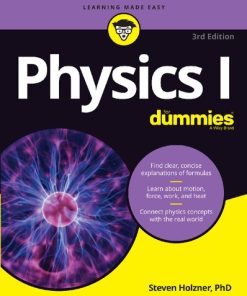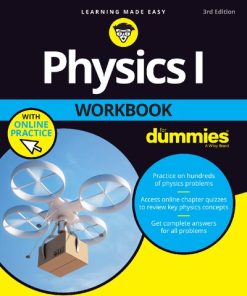Physics I 501 Practice Problems For Dummies 1st edition by The Experts At Dummies 1119883739 9781119883739
$50.00 Original price was: $50.00.$25.00Current price is: $25.00.
Physics I: 501 Practice Problems For Dummies 1st edition by The Experts At Dummies – Ebook PDF Instant Download/DeliveryISBN: 1119883739, 9781119883739
Full download Physics I: 501 Practice Problems For Dummies 1st edition after payment.

Product details:
ISBN-10 : 1119883739
ISBN-13 : 9781119883739
Author : The Experts At Dummies
Physics I: 501 Practice Problems For Dummies gives you 501 opportunities to practice solving problems from all the major topics covered you Physics I class–in the book and online! Get extra help with tricky subjects, solidify what you’ve already learned, and get in-depth walk-throughs for every problem with this useful book. These practice problems and detailed answer explanations will help you succeed in this tough-but-required class, no matter what your skill level. Thanks to Dummies, you have a resource to help you put key concepts into practice.
Physics I: 501 Practice Problems For Dummies 1st Table of contents:
Part 1: The Questions
Chapter 1: Reviewing Math Fundamentals and Physics Measurements
The Problems You’ll Work On
What to Watch Out For
Equipping Yourself with Basic Algebra
Tackling a Little Trigonometry
Converting between Units
Practicing Scientific Notation
Understanding Unit Prefixes
Spotting the Number of Significant Digits
Rounding to the Correct Number of Digits
Chapter 2: Moving along with Kinematics
The Problems You’ll Work On
What to Watch Out For
Determining Displacement Using Positions in One Dimension
Getting Displacement in Two Dimensions with Axes
Traveling with Average Speed and at Instantaneous Speed
Distinguishing between Average Speed and Average Velocity
Speeding Up and Down with Acceleration
Finding Displacement with Acceleration and Time
Finding Displacement with Acceleration and Velocities
Finding Acceleration with Displacement and Time
Finding Acceleration with Velocities and Displacement
Finding Velocities with Acceleration and Displacement
Chapter 3: Moving in a Two-Dimensional World
The Problems You’ll Work On
What to Watch Out For
Getting to Know Vectors
Adding and Subtracting Vectors
Adding Vectors and Subtracting Vectors on the Grid
Breaking Vectors into Components
Reassembling a Vector from Its Components
Describing Displacement, Velocity, and Acceleration in Two Dimensions
Moving under the Influence of Gravity: Projectile Launched Horizontally
Moving under the Influence of Gravity: Projectile Launched at an Angle
Chapter 4: Pushing and Pulling: The Forces around You
The Problems You’ll Work On
What to Watch Out For
Resisting Motion with Newton’s First Law
Forcing a Massive Object to Accelerate
Drawing Free-Body Diagrams
Adding Forces Together to Obtain the Net Force
Moving a Distance with the Net Force
Finding the Needed Force to Speed Up
Pairing Up Equal and Opposite Forces
Overcoming Friction by Pulling Hard
Pulling in a Different Direction with Pulleys
Balancing the Forces to Find Equilibrium
Chapter 5: Slipping and Sliding: Motion and Forces
The Problems You’ll Work On
What to Watch Out For
Finding the Gravity along a Slope
Moving Fast with Gravity down a Slippery Slope
Getting Unstuck with the Coefficient of Friction
Starting Motion with Static Friction
Keeping on Moving with Kinetic Friction
Pushing and Pulling on a Non-Slippery Slope
Covering the Distance on a Non-Slippery Slope
Shooting Objects Straight Up to the Maximum Height
Taking the Time to Go Up and Down
Shooting at an Angle: Separating the Motion in Components
Reaching Far with a Projectile
Chapter 6: Describing Rotational Motion
The Problems You’ll Work On
What to Watch Out For
Keeping a Constant Speed around a Circle
Measuring Angles in Radians
Traveling in a Circle with Angular Velocity
Speeding Up and Down around a Circle with Angular Acceleration
Accelerating toward the Center with Centripetal Acceleration
Providing the Centripetal Force Based on Mass, Velocity, and Radius
Chapter 7: Rotating Around in Different Loops
The Problems You’ll Work On
What to Watch Out For
Turning on a Flat Road with a Little Help from Friction
Making a Banked Turn in Debt to Normal Force
Applying the Law of Universal Gravitation to the Stars
Accelerating with Gravity Near a Planet’s Surface
Finding the Speed of the Satellites in Circular Orbits
Taking the Time to Travel around Celestial Bodies
Moving Fast to Avoid Falling Off in a Vertical Loop
Chapter 8: Going with the Flow: Fluids
The Problems You’ll Work On
What to Watch Out For
Getting Denser with More Mass Packed Together
Comparing Densities Using Specific Gravity
Applying Pressure with a Force
Working under Pressure: Calculating the Pressure at a Depth
Passing on Pressure with Pascal’s Principle
Floating with Archimedes’ Principle
Distinguishing Different Types of Flow
Flowing Faster with a Smaller Pipe
Relating Pressure and Speed with Bernoulli’s Equation
Putting It All Together with Pipes
Chapter 9: Getting Some Work Done
The Problems You’ll Work On
What to Watch Out For
Applying Force in the Direction of Movement
Applying Force at an Angle
Applying Force in the Opposite Direction of Motion
Finding the Kinetic Energy of a Moving Object
Turning Work into Kinetic Energy
Banking on Potential Energy by Working against Gravity
Cashing Out Potential Energy to Kinetic Energy
Maintaining the Total Mechanical Energy
Gaining Power by Doing More Work Faster
Powering Up with Speed
Chapter 10: Picking Up Some Momentum with Impulse
The Problems You’ll Work On
What to Watch Out For
Applying Force for a Period of Time: Impulse
Gathering Momentum in All Directions
Supplying Impulse to Change Momentum
Finding Force from Impulse and Momentum
Conserving Momentum during Collisions
Sticking Together: Finding the Velocity in Inelastic Collisions
Finding the Initial Velocity of Collisions
Colliding Elastically along a Line
Colliding Pool Balls: Elastic Collisions in Two Dimensions
Chapter 11: Rolling Around with Rotational Kinetics and Dynamics
The Problems You’ll Work On
What to Watch Out For
Linking Linear and Tangential Motion with Radius
Finding Centripetal Acceleration
Figuring Out Angular Velocity and Acceleration
Twisting Around with Torque
Lifting Some Weights: An Exercise in Rotational Equilibrium
Hanging Signs up and Keeping the Torques Balanced
Leaning against the Wall with Help from Friction
Converting Tangential Acceleration to Angular Acceleration in Newton’s Second Law
Looking into Mass Distribution to Find Moments of Inertia
Relating Torque, Angular Acceleration, and Moments of Inertia
Putting a Spin on Work
Rolling with Rotational Kinetic Energy
Finding Rotational Kinetic Energy on a Ramp
Conserving Angular Momentum
Chapter 12: Bouncing with a Spring: Simple Harmonic Motion
The Problems You’ll Work On
What to Watch Out For
Compressing and Stretching Springs: The Spring’s Restoring Force
Getting around the Equilibrium
Riding the Sine Wave of Simple Harmonic Motion
Finding Period and Frequency
Linking Position, Velocity, and Acceleration
Finding the Period of a Mass on a Spring
Taking Energy into Account in Simple Harmonic Motion
Swinging with Pendulums
Chapter 13: Heating Up with Thermodynamics and Heat Transfer
The Problems You’ll Work On
What to Watch Out For
Measuring Temperature in Different Ways
Getting to the Coldest Zone
Expanding with the Heat: Getting Longer
Expanding with the Heat: Taking Up More Space
Changing the Temperature with Energy Flow
Gaining or Losing Energy to Change into a New Phase
Rising with the Hot Fluid in Convection
Getting in Touch with Thermal Conduction
Working with Thermal Conductivity
Radiating with Black Bodies
Chapter 14: Living in an Ideal World with the Ideal Gas Law
The Problems You’ll Work On
What to Watch Out For
Finding Number of Molecules in Moles with Avogadro’s Number
Working with Boyle’s Law When Temperature Is Constant
Working with Charles’s Law When Pressure Is Constant
Relating Pressure, Volume, and Temperature with the Ideal Gas Law
Calculating the Kinetic Energy of the Ideal Gas Molecules
Chapter 15: Experiencing the Laws of Thermodynamics
The Problems You’ll Work On
What to Watch Out For
Conserving Energy Using the First Law: Heat and Work
Staying at Constant Pressure in Isobaric Processes
Staying at Constant Temperature in Isothermal Processes
Staying at Constant Volume in Isochoric Processes
Staying at Constant Heat in Adiabatic Processes
Putting Heat to Work with Heat Engines
Evaluating Efficiency of Heat Engines
Going against the Flow with Heat Pumps
Part 2: The Answers
Chapter 16: Answers
People also search for Physics I: 501 Practice Problems For Dummies 1st:
physics i 501 practice problems for dummies
physics real world problems
physics problems that haven’t been solved
physics 1 practice problems with answers
physics 111 practice problems
Tags: Physics, Practice Problems, Dummies, The Experts At Dummies
You may also like…
Chemistry - Organic Chemistry
Organic Chemistry I Workbook For Dummies 2nd Edition Arthur Winter 9781119296577 1119296579
Business & Economics - Personal Finance
500 Great Ways to Save For Dummies 1st Edition The Experts At Aarp
Uncategorized
Education Studies & Teaching - Higher & Further Education
Travel - Europe - Travel
Education Studies & Teaching - Studying & Test Preparation
Physics I Workbook For Dummies with Online Practice 3rd Edition The Experts At Dummies
Business & Economics - Personal Finance











